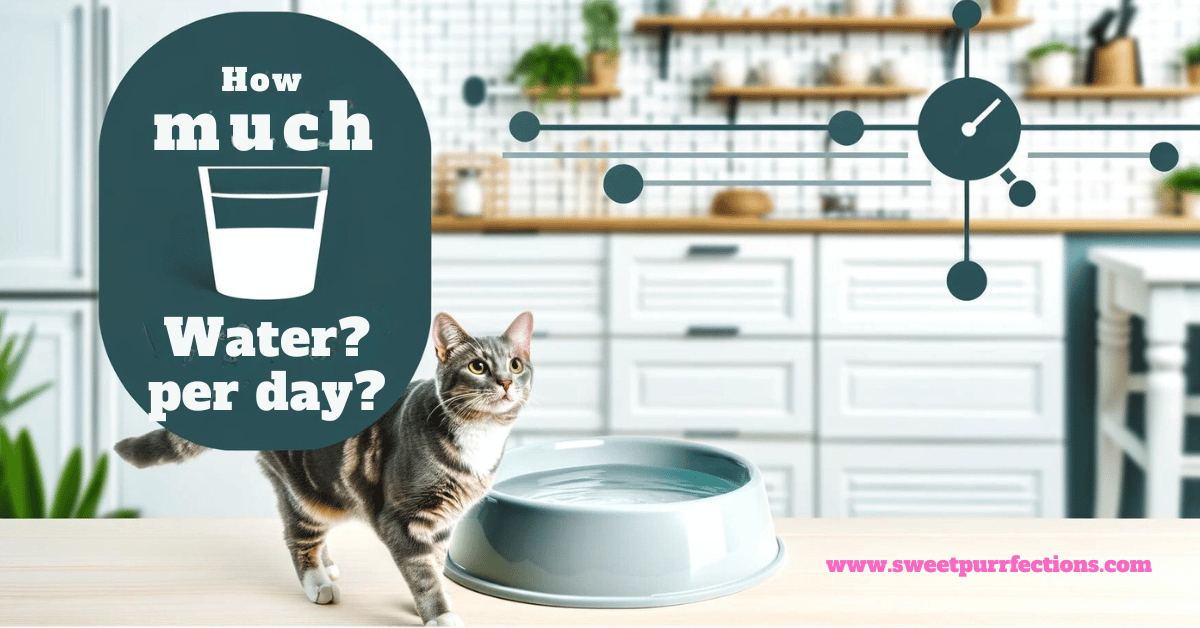This post contains affiliate links and I will be compensated if you make a purchase after clicking on my links.
Why Hydration is Crucial for Your Cat’s Health
Water is fundamental to a cat’s health. Every aspect of their physiology, from proper kidney function to maintaining a lush fur coat, is influenced by their hydration status. Even mild dehydration can pose significant health risks to cats, potentially leading to reduced kidney efficiency, urinary tract diseases, and other serious health complications
Let’s dive into the details of how much water does a cat need per day, taking various important factors into consideration.
Key Hydration Facts Every Cat Owner Should Know
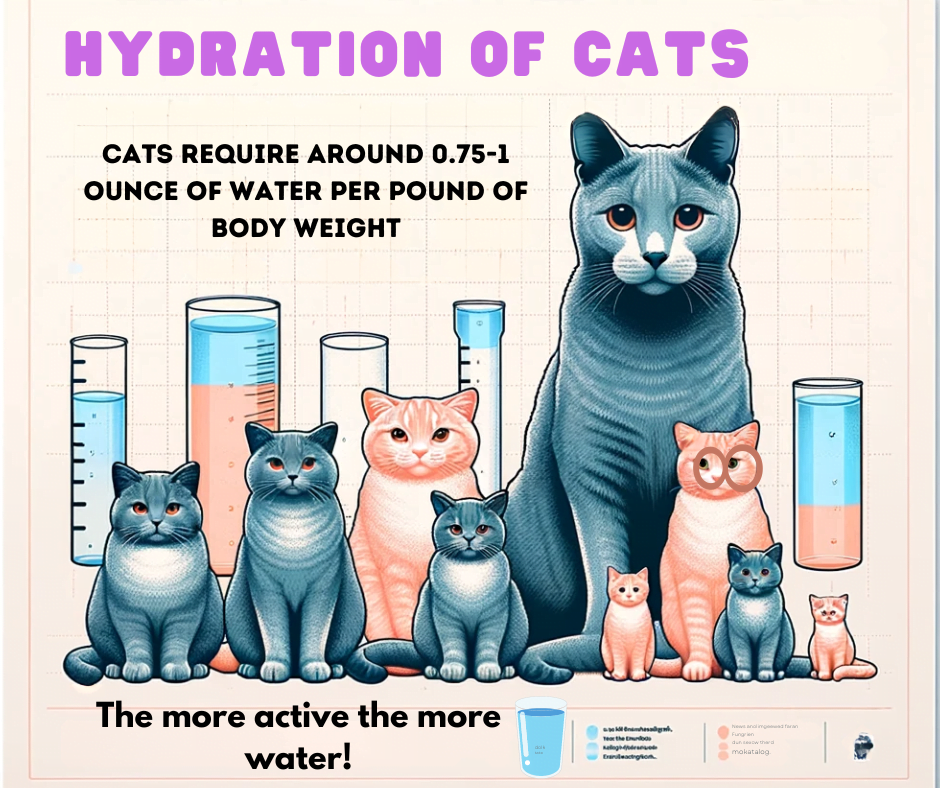
The rule of thumb is that cats require around 0.75-1 ounce of water per pound of body weight or approximately 1 cup of water a day for adult cats. However, it’s important to note that this is just a general guideline.
The actual amount can vary based on factors like the cat’s diet, activity level, and environmental conditions. For instance, a cat on a dry food diet might need more water compared to one on a wet food diet, as wet food can contribute significantly to their hydration needs.
Fun Fact: Did you know that a cat’s sense of thirst is not as sharp as a dog’s? This evolutionary trait stems from their ancestors, who originated in arid environments and got most of their water from prey. This is why your house cat might not always drink enough water, making it crucial for you to monitor their hydration!
How Much Water Does a Cat Need Per Day? Getting the Exact Measurements
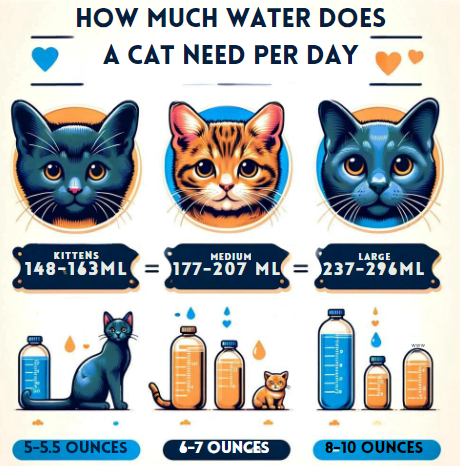
When it comes to hydration, one size does not fit all. Just like humans, cats have varying water requirements depending on their size and age. Understanding these differences is key to ensuring your cat stays well-hydrated.
- Kittens: These energetic little ones need about 148-163 milliliters (ml) [5-5.5 ounces] of water daily. Considering their smaller size, even a minor shortfall in water intake can significantly impact their health.
- Medium Cats: An average adult cat requires approximately 177-207 ml [6-7 ounces] of water each day. It’s crucial to monitor their intake, especially if they are active or live in warmer climates.
- Large Cats: Larger cats have greater hydration needs. A large cat should consume roughly 237-296 ml [8-10 ounces] of water daily to maintain their health.
Factors Affecting Your Cat’s Hydration Needs: From Diet to Weather
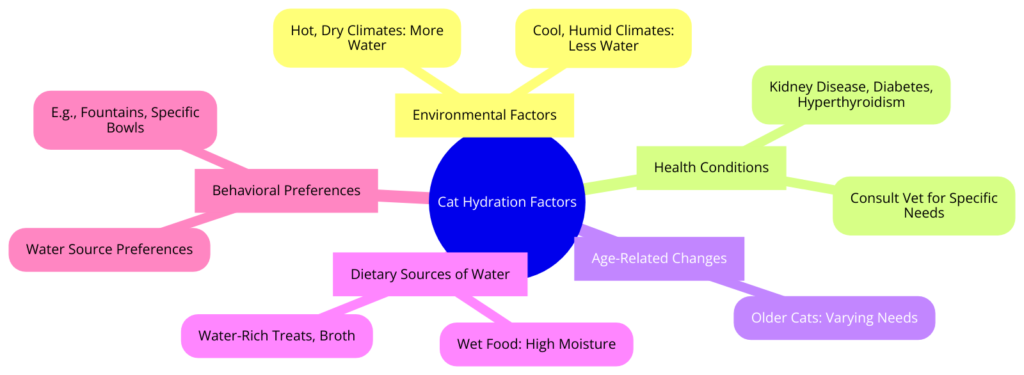
- Environmental Factors: The climate you live in can influence your cat’s water intake. In hot, dry conditions, your cat may need more water, while in cooler, more humid environments, they might drink less.
- Health Conditions: Cats with health issues like kidney disease, diabetes, or hyperthyroidism may have altered water requirements. Consult your vet for specific guidance.
- Age-Related Changes: As cats age, their water needs can change. Older cats might drink less due to decreased activity or kidney efficiency.
- Dietary Sources of Water: Besides drinking water, cats also obtain moisture from their food. Wet food is particularly hydrating and can be a key source of water, especially for cats that prefer it over drinking water. Additionally, water-rich treats or a small amount of broth (ensure it’s cat-safe and free from harmful ingredients like onion and salt) can supplement their hydration.
- Behavioral Preferences: Cats often have specific preferences for water sources. Some might prefer running water from a fountain, while others might favor certain types of bowls or specific locations. Observing and accommodating these preferences can help encourage better water intake.
Preventing Cat Dehydration: Signs and Solutions
Dehydration in cats can be subtle, often remaining unnoticed until it reaches severe levels. It’s crucial to be aware of the signs of dehydration for timely intervention. Keep an eye out for symptoms including:
- Dry gums
- Increased skin tenting (skin staying elevated when pinched)
- Lethargy or less activity than usual
- Sunken eyes
- Weakness or collapse in severe cases
If you notice any of these signs, it’s crucial to act quickly. Dehydration can escalate from a mild concern to a life-threatening condition in a short amount of time. This is not just a cautionary note; it’s a strong warning that dehydration may require urgent medical intervention.
In some cases, immediate veterinary care involving intravenous (IV) fluids and hospitalization is necessary, especially if linked to underlying health issues like kidney disease or diabetes.
Delaying treatment for dehydration can lead to severe health complications. Your prompt response can prevent further health decline and could be life-saving.
How to Check If Your Cat is Well-Hydrated: Simple Steps
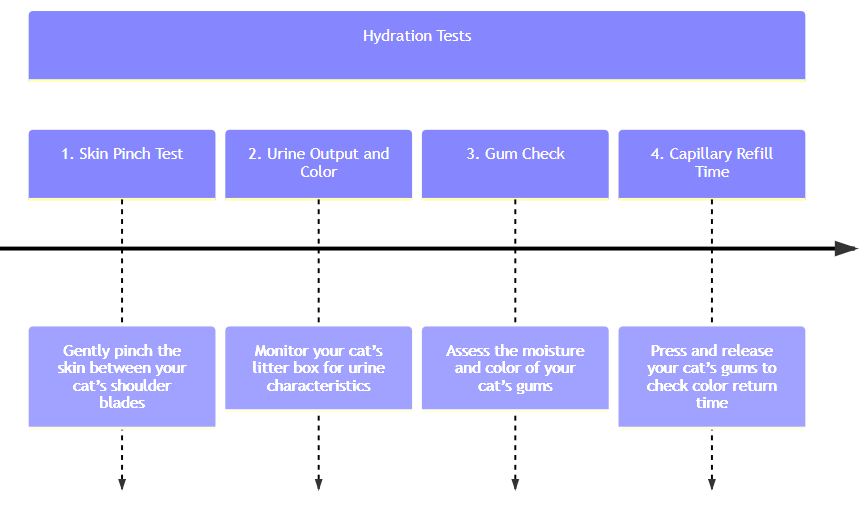
Keeping an eye on your cat’s hydration status is as important as ensuring they have enough water. Here are four simple ways to check if your cat is well-hydrated:
- Skin Pinch Test: Gently pinch the skin between your cat’s shoulder blades, lift it up, and then let go. In a well-hydrated cat, the skin should snap back into place quickly. If the skin stays tented or returns slowly, it could indicate dehydration.
- Urine Output and Color: Monitor your cat’s litter box. Reduced urine output or unusually dark urine can be signs of dehydration. Well-hydrated cats typically have pale yellow urine.
- Gum Check: Look at your cat’s gums; they should be moist and pink. Dry or tacky gums are a sign of dehydration. This test is a quick and easy way to assess hydration status.
- Capillary Refill Time: Gently press on your cat’s gums until they turn white, then release. The color should return to normal within about 2 seconds. Delayed color return can indicate dehydration.
Tips to Encourage Your Cat to Drink More Water
Ensuring your cat drinks enough water can be a challenge, but there are several strategies to encourage them:
- Cat Water Fountains: Many cats prefer running water, and a fountain can entice them to drink more frequently.
- Fresh Water: It’s essential to always provide fresh, clean water for your cat. Regularly cleaning and refilling their water bowls not only encourages more frequent drinking but is also crucial for their health. Maintaining clean water helps prevent the buildup of bacteria and ensures that your cat stays hydrated with safe, hygienic water.
- Wet Food: Incorporating wet food into your cat’s diet is an excellent way to increase their water intake. If you’re looking for a great option, check out our review of Inaba Ciao cat food, a brand renowned for its hydrating and nutritious qualities.
Fun fact: Cats have a preference for the temperature of their water. Research has shown that many cats prefer water that’s at room temperature, just like their prey in the wild. So, try offering your cat room-temperature water to encourage better hydration habits!
Ensuring Proper Hydration for Your Cat: Final Thoughts
In our busy lives, it can be challenging to meticulously monitor every milliliter of water our cats consume. However, by being observant of various signs, we can get a good understanding of their hydration levels. Look for cues like how often they drink, the water level in their bowl, and the moisture content of their food. Remember, changes in drinking habits can be subtle but significant indicators of their hydration status.
If you’re unsure or concerned about your cat’s hydration levels, a technological solution might be ideal. Consider using modern cat bowls and fountains that are equipped with monitoring capabilities. These devices can connect to an app, allowing you to track your cat’s water intake precisely and effortlessly. This technology is particularly useful if you’re trying to determine how much water does a cat need per day to keep your feline friend consistently well-hydrated.
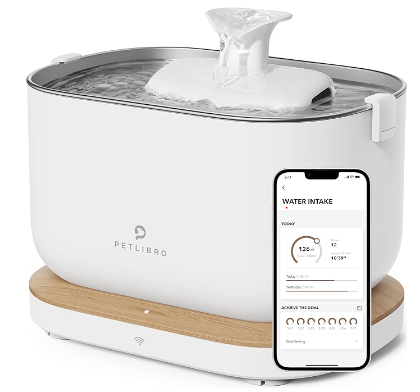
Meet Sean, a fintech whiz with a penchant for pet purrs and blockchain buzz. After a decade of fintech feats, Sean’s tech talents leaped from ledger lines to litter lines, driven by a passion for pets and a vision for a more connected pet care community. With three critter companions as co-pilots, Sean launched this blog to share a treasury of pet-friendly tech tips and tales.

